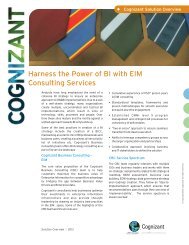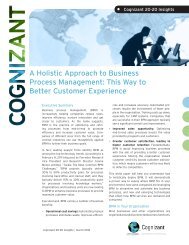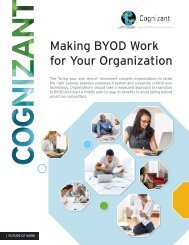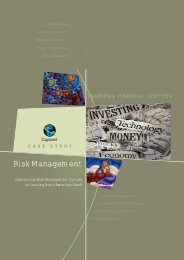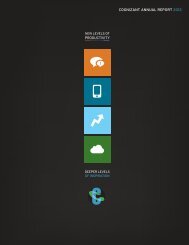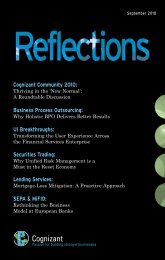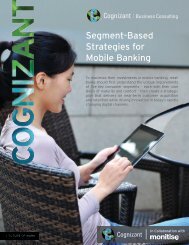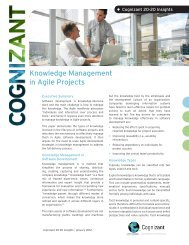The 21st Century CIO -- Leading IT Transformation in a ... - Cognizant
The 21st Century CIO -- Leading IT Transformation in a ... - Cognizant
The 21st Century CIO -- Leading IT Transformation in a ... - Cognizant
Create successful ePaper yourself
Turn your PDF publications into a flip-book with our unique Google optimized e-Paper software.
manage its applications portfolio and its full lifecycle software development needs, <strong>in</strong>clud<strong>in</strong>g ma<strong>in</strong>tenance and test<strong>in</strong>g. <strong>The</strong> netresult: 75% of the <strong>in</strong>ternal <strong>IT</strong> organization function was outsourced, and its operational performance cont<strong>in</strong>ues to improve.<strong>The</strong> company also brought <strong>in</strong> a new <strong>CIO</strong> whose mission is to lead this radical transformation. He placed a high priority on moreclosely align<strong>in</strong>g <strong>IT</strong> with the bus<strong>in</strong>esses and transform<strong>in</strong>g the <strong>IT</strong> organization <strong>in</strong>to a source of competitive advantage. <strong>Cognizant</strong>was <strong>in</strong>strumental <strong>in</strong> help<strong>in</strong>g this <strong>CIO</strong> develop, plan and implement the various components of this <strong>in</strong>itiative, which is see<strong>in</strong>g greatprogress today.<strong>CIO</strong> Makeover<strong>The</strong> <strong>CIO</strong> at this Fortune 100 company is a great example of the type of leader needed to effect quantum <strong>IT</strong> transformation. He’s apositive th<strong>in</strong>ker, capable of motivat<strong>in</strong>g his team and align<strong>in</strong>g them with his agenda. He is also focused on strategic rather thantactical concerns, yet drives his teams to develop roll<strong>in</strong>g plans to implement their strategic objectives.At many organizations -- <strong>in</strong>clud<strong>in</strong>g the company cited above -- <strong>IT</strong> has historically operated without an explicit strategic plan <strong>in</strong>place. So a natural start<strong>in</strong>g po<strong>in</strong>t for the <strong>CIO</strong> <strong>in</strong> a transformative environment is align<strong>in</strong>g and def<strong>in</strong><strong>in</strong>g the <strong>IT</strong> strategy and help<strong>in</strong>gto determ<strong>in</strong>e the organization’s goals and objectives. This allows the <strong>CIO</strong> to beg<strong>in</strong> manag<strong>in</strong>g the <strong>IT</strong> portfolio to maximizereturn on <strong>in</strong>vestment. Enabl<strong>in</strong>g this requires a strong approach to portfolio management, and perhaps even establish<strong>in</strong>g orreshap<strong>in</strong>g an exist<strong>in</strong>g project management office or team. In the case of the consumer goods company, <strong>Cognizant</strong> worked to centralizeprogram management and create better governance and metrics by reorganiz<strong>in</strong>g the office of project management to alignbetter with the new <strong>IT</strong> structure.<strong>CIO</strong>s need to rise above the status quo andtake on a new set of activities that has them<strong>in</strong>volved <strong>in</strong> the strategy developmentprocess from the get-go.A third strategic role is design<strong>in</strong>g an enterprise architecture that enables bus<strong>in</strong>ess agility. Although this requires a hefty upfront<strong>in</strong>vestment, the speed of change that most companies require cannot be supported without a flexible, agile technologyarchitecture. <strong>IT</strong> leaders who boldly take on these challenges are, <strong>in</strong> our view, progressive “<strong>21st</strong> <strong>Century</strong> <strong>CIO</strong>s.” <strong>The</strong>y are amongthe few <strong>CIO</strong>s who are well-armed and positioned to effect the quantum change required to transform their organizations <strong>in</strong>tostrategically-valued partners.Help<strong>in</strong>g Transform <strong>The</strong> Bus<strong>in</strong>essChange-effect<strong>in</strong>g <strong>CIO</strong>s drive <strong>in</strong>creas<strong>in</strong>g <strong>in</strong>teraction between their <strong>IT</strong> departments and the bus<strong>in</strong>ess units, thereby <strong>in</strong>creas<strong>in</strong>g <strong>IT</strong>’sacceptance by the bus<strong>in</strong>ess. To accomplish this, they need to connect <strong>in</strong>creas<strong>in</strong>gly with the CEO, their bus<strong>in</strong>ess peers and theirdirect reports. It’s only by discover<strong>in</strong>g what is truly driv<strong>in</strong>g the bus<strong>in</strong>ess that they’ll beg<strong>in</strong> to recognize <strong>in</strong>novative ways to usetechnology to drive competitive advantage. In this newly elevated position, they can beg<strong>in</strong> educat<strong>in</strong>g the enterprise on whattechnology is and isn’t capable of do<strong>in</strong>g, with<strong>in</strong> the organization’s budgetary, architectural and strategic limits. <strong>The</strong>y can alsobeg<strong>in</strong> to not just support but also genu<strong>in</strong>ely lead bus<strong>in</strong>ess change.To <strong>in</strong>ternalize a desired level of bus<strong>in</strong>ess understand<strong>in</strong>g with<strong>in</strong> the DNA of the <strong>IT</strong> department, the various functional leaders --along with members of vital groups such as bus<strong>in</strong>ess partners, program management, enterprise architecture and <strong>in</strong>frastructure-- should be urged to follow a structured program to <strong>in</strong>crease their knowledge and experience of the world <strong>in</strong> which the bus<strong>in</strong>essunits operate. Such a program would typically start with an understand<strong>in</strong>g of the end-to-end bus<strong>in</strong>ess system of the company. Forexample, <strong>in</strong> a product-oriented firm, participants should <strong>in</strong>clude divisions such as purchas<strong>in</strong>g, R&D, production, distribution,market<strong>in</strong>g, sales, service and the competitive and product-market environments <strong>in</strong> which the bus<strong>in</strong>ess units compete globally.<strong>The</strong> program should also <strong>in</strong>clude a “day <strong>in</strong> the life” menu of bus<strong>in</strong>ess activities that <strong>IT</strong> personnel should experience first-hand.For <strong>in</strong>stance, <strong>in</strong> a soft dr<strong>in</strong>ks company, this could <strong>in</strong>clude rid<strong>in</strong>g with delivery representatives, observ<strong>in</strong>g a production l<strong>in</strong>e orexperienc<strong>in</strong>g first-hand the company’s markets <strong>in</strong> Ch<strong>in</strong>a, India or Brazil. Further down the road, it could <strong>in</strong>clude <strong>IT</strong> directors andkey managers attend<strong>in</strong>g the non-<strong>IT</strong> forums and conferences recommended by bus<strong>in</strong>ess units as these are important ways ofkeep<strong>in</strong>g abreast of market developments and <strong>in</strong>teract<strong>in</strong>g with customers and competitors.2




